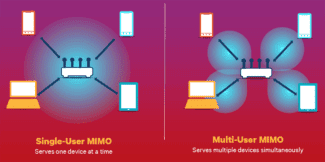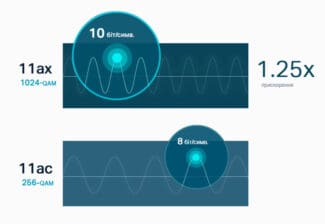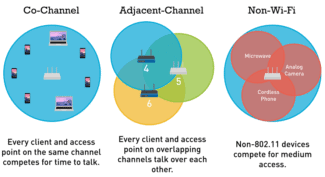The development of networks for cell phones is also moving forward. In the spring, Samsung revealed the creation of technology that should become the basis in the transmission of the 5th generation (5G) mobile network. The transmitter made by the company showed a speed of more than 1 Gbit / s at a distance of up to 2 km. In reality, this result means that HD video can be downloaded to a tablet or smartphone in half a second, and a movie in ten seconds. However, despite the achievement, it will not be possible to use 5G networks before 2020.
- 11ac – the new Wi-Fi standard
- Learn more about IEEE 802ac Wi-Fi technology:
- What’s the point?
- The customer isn’t always right yet
- Increased number of spatial streams
- Support for new high-density 256-QAM modulation
- 2015: Ministry of Communications has legalized 802.11ac
- Can an 802.11ac Wave 2 access point handle 1 Gbps of traffic?
- What frequency bands are used by 802.11ac Wave?
11ac – the new Wi-Fi standard
The extraordinary growth in the volume and types of various Wi-Fi devices, coupled with the increasing popularity of high-definition video streaming, is generating demand for more advanced and high performance technology. The 802.11ac communications standard is a new Wi-Fi standard that is designed to meet these needs.
The new communications standard makes it possible to greatly expand network capacity, from 430 Mbit/s (devices at 433 Mbit/s per channel were already available in 2014) to a maximum speed of 6.77 Gbit/s with 8x MU-MIMO antennas. This is the most significant innovation in this area relative to IEEE 802.11n. It is also expected to reduce power consumption (J/bit) and this, in turn, will increase independent uptime for all mobile devices.
Learn more about IEEE 802ac Wi-Fi technology:
The first starting point in the history of 802.11ac can be taken as early 2011, at a time when the Institute of Electrical Engineers (IEEE) took the first draft version of the next “version” of Wi-Fi. And just six months later, Quantenna threw on the market the first such chipset, which is perfectly compatible with routers as well as commercial devices. Another important milestone in the development of high-speed Wi-Fi can be taken from the 2014 CES exhibition. At this exhibition, the new controllers were announced by the major chip manufacturer Broadcom, while Lenovo, ZTE, Huawei, Comcast and other well-known players in the modern electronics market decided to implement them in their own products.
What is the difference between the new standard 802.11ac and the more common 802.11n?
- The major difference is that the new standard offers many times faster data transfer rate (theoretically 1.3 Gbit), which will be beneficial for streaming media (especially HD video), mobile applications and data transfer. 802.11n guarantees a maximum data rate of 150 Mbps from a single antenna, 300 from 2 antennas and 450 from 3 antennas. With 802.11ac, these numbers are several orders of magnitude higher: 450/900 and 1.3 Gbps. Also, the speed of 802.11ac-compatible devices with eight antennas at once can reach 6-7 Gbit/s.
- Another advantage of the new Wi-Fi standard is an even wider range of network coverage and a stronger and more stable signal, which makes it possible to cover an apartment using only one router. These improvements have been achieved through the beamforming technology used (the so-called “bimforming”) – which is able to recognize the location of an installed device and send the Wi-Fi signal directly to that device.
- Electronics with “outdated” Wi-Fi works mainly on the heavily populated 2.4 GHz frequency, sharing it with the microwave and other appliances nearby. Consequently, another advantage of the 802.11ac standard is that it eliminates interference by operating on the 5 GHz band.
- The process of transition to 802.11ac will last for several years, so devices and appliances working on the new Wi-Fi standard are planned to support backward compatibility with legacy standards. You won’t have to throw out your router after buying a new device: they will be able to automatically switch from 5GHz to 2.4GHz if necessary.
What’s the point?
Really, why do we need these adventures when there is 802.11n? First, the facility may not have a Wi-Fi network at all yet and there is a great temptation to do it immediately on the newest hardware. Secondly, there may be a network, but an old one, in 802.11 a/b/g. Thirdly, it could be 802.11n, but it is single-band and only on 2.4 GHz, and this part of the spectrum is extremely crowded, especially if your office is not a lonely hut in a dense forest (and even then, if there is external video surveillance with wireless cameras around the hut, the spectrum can be decently littered). Fourth, the 802.11ac standard has tasty “pluses” in comparison with 5-gigahertz 802.11n networks. We have already written in detail and competently about these advantages on Habra, so let’s not repeat them, but talk about practice: what to choose from and how to build.
All vendors of enterprise-class wireless equipment (we shall not discuss home solutions, it is another niche) are rushing to release 802.11as products. Market leader Cisco was in such a hurry to secure its place that it released the Cisco Aironet 3600 Series a year ago, announcing 802.11ac support for these access points, but without including the appropriate radio module. They promised to provide the module “later” (yes, such an interesting marketing ploy: buy a machine gun today, and we will deliver an underbarrel grenade launcher to it later). It must be said that they were not deceived, in April 2013 Cisco started shipment of the module which can be quite easily inserted into the access point.

However, they are not going to stop: in a year and a half a second wave module (Wave 2) is promised, with support for MU-MIMO and rates up to 6.9 Gbps, which means a channel width of 160 MHz and 8 spatial streams. Again, when it comes to the actual rates between a single client and an access point, the bottle neck will be the clients. Eight spatial streams per client is the stuff of fantasy, but 802.11ac is precisely the good news in that excess spatial streams are not “lost” but are used in MU-MIMO to serve other clients:
The customer isn’t always right yet
What have we got so far in the area of client devices? Not too much so far. The first wave are adapters with 80 MHz channel widths, mostly with support for two spatial streams, such as Netgear A6200 и D-Link DWA-182 (both on the Broadcom chipset). For such adapters, the theoretical PHY-rate limit is 866.7 Mbps, and it will definitely be written on the box, but the modestly omitted fact that spoils the whole picture is the USB 2.0 bus with a maximum theoretical data transfer rate of 480 Mbps. In practice, under ideal conditions, USB 2.0 adapters do not give a real data rate (i.e. throughput) above 230 Mbps. On the next step of the evolutionary ladder there are models for USB 3.0, so far with the same channel width of 80 MHz and two streams, such as ZyXEL NWD6605., Edimax EW-7822UAC и Linksys WUSB6300 (all three on Realtek chipset). Due to adequate bus speed you can expect throughput at 380-500 Mbps. On the top step are integrated notebook mPCIe-adapters, some even with three streams, which can achieve a real speed of 550-750 Mbps. However, note that laptops with 802.11ac are still very few.
What can we expect from clients in the future? Apparently, low-end clients will be single-threaded, high-end clients will remain three-threaded. The channel width will most likely reach 160 MHz. Why will there be so few spatial threads, why not 4 or 8? The answer lies mostly in the area of power consumption. Each additional thread is an additional radio path, which increases power consumption (unlike, by the way, the channel width, which has almost no effect on power consumption). A smartphone with three streams will drain the battery very quickly. For those interested in the details of MIMO devices power consumption, I refer you to an interesting study.
Increased number of spatial streams
The previous 802.11n standard allowed up to 4 spatial streams, while 802.11ac has been expanded to 8 (optional*).
When radio signals are transmitted simultaneously from different antennas, to avoid collisions the transmissions must be made through separate spatial streams (Spatial Streams).

MIMO (Multiple-Input Multiple-Output) technology enables simultaneous reception/transmission of multiple data streams through multiple antennas. The more spatial streams, the more antennas are required to transmit and receive them. The more antennas the device uses for simultaneous transmit/receive operation, the higher the maximum data rate will be.
Support for new high-density 256-QAM modulation
The 802.11ac implementation of a new and higher performance 256-QAM signal modulation system provides an increase in throughput in the wireless network.
256-QAM modulation compared to 64-QAM (on 802.11n) significantly (up to about 25%) increases data throughput.
For example, on 802.11ac with a channel width of 40 MHz, using 1 spatial stream and modulation 256-QAM the maximum speed in the channel is 200 Mbps, and on 802.11n with the same parameters, but modulation 64-QAM is 150 Mbps.
Now, knowing the channel width, the number of spatial streams and the type of modulation used by the device, you can find out the maximum possible theoretical data transfer speed in each case.
Below is a table of maximum data rates (Data Rate) of 802.11ac, depending on various parameters: modulation type (Modulation), coding rate (Coding Ratio), the number of spatial streams (Spatial Stream), channel width (20/40/80/160-MHz).
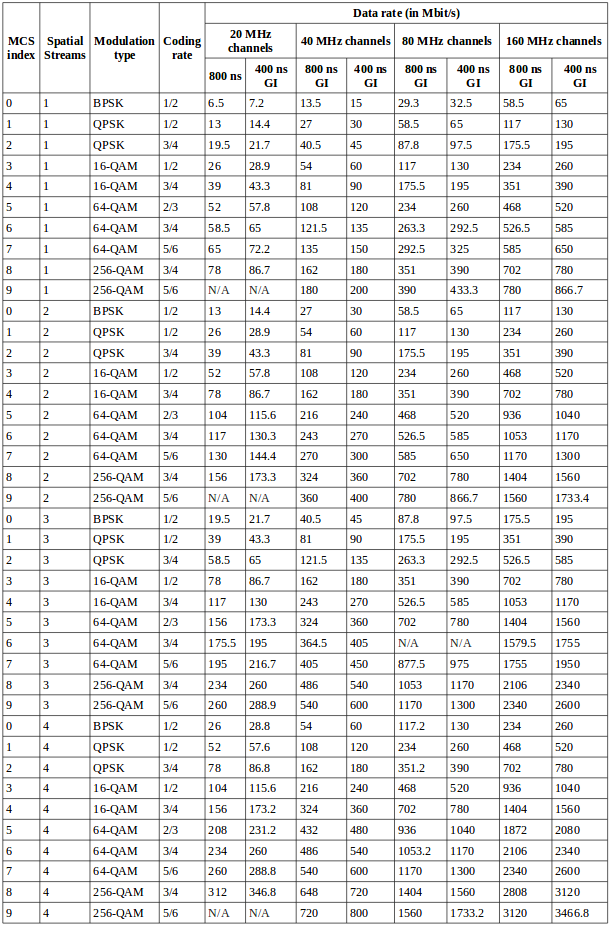
For example, we can calculate the maximum theoretical speed, which can provide the standard 802.11ac.
On a single spatial stream, with a channel width of 160 MHz and 256-QAM modulation the maximum theoretical speed is 867 Mbit/s. The 802.11ac standard optionally* supports 8 spatial streams. Multiply 8 by 8 and you get a speed value of about 7 Gbit/s, which is significantly higher than the maximum theoretical speed on 802.11n (it is 600 Mbit/s with 4 spatial streams, each at 150 Mbit/s).
2015: Ministry of Communications has legalized 802.11ac
The Ministry of Communications published an order that approves the rules for 802.11ac and 802.11ad Wi-Fi equipment. The agency also supports the expansion of frequency bands in the 5 GHz band for the use of 802.11ac without restrictions, but this decision must be made by the State Commission for Radio Frequencies (SCRF).
Order of the Ministry of Communications and Mass Media of the Russian Federation No. 129 “On Amendments to the Rules of Application of Radio Access Equipment. Part I. Rules of application of radio access equipment for wireless data transmission in the range from 30 MHz to 66 GHz, approved by the order of the Ministry of Communications and Mass Media of the Russian Federation from 14.09.2010 № 124 p”, was signed by the head of the department Nikolai Nikiforov on April 22, 2015. On May 14, the document was registered at the Ministry of Justice, and on May 18 it was published on the official Internet portal of legal information Рravo.gov.ru. The order will take effect 10 days after publication.
The 802.11ac standard operates in the 5 GHz frequency band at 5150-5350 MHz, but 802.11ac radio-electronic devices (RENs) need to expand that band to operate without restrictions.
Can an 802.11ac Wave 2 access point handle 1 Gbps of traffic?
Potentially, next-generation access points can handle that kind of traffic flow. Actual throughput depends on a number of factors ranging from the number of streams supported, the range of the link, the presence of obstacles, to the presence of interference, and the quality of the access point and client module.
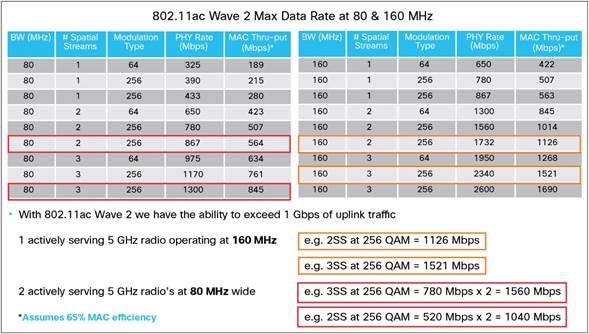
What frequency bands are used by 802.11ac Wave?
The choice of operating frequency depends solely on regional regulations. The list of channels and frequencies changes all the time, here is the US (FCC) and Europe as of January 2015.
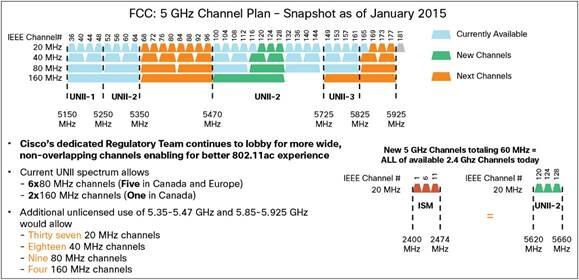
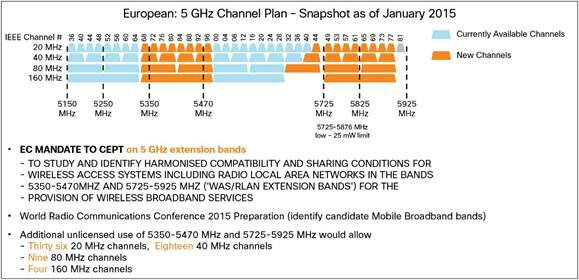
In Europe, channel widths greater than 40 MHz are allowed, so there is no change in terms of the new standard, all the same rules apply as for the previous standard.
Read More:
